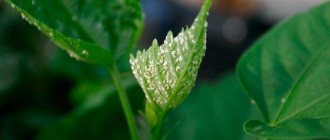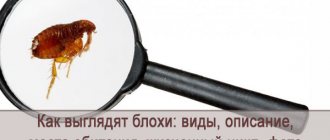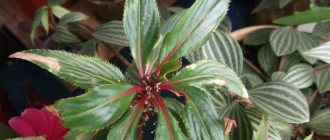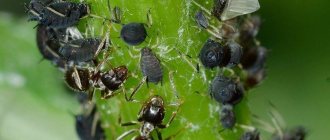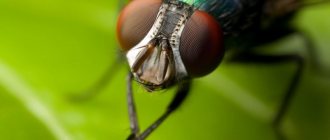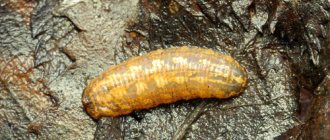The topic of how to deal with whiteflies in a greenhouse is of interest not only to novice gardeners, but also to people who have extensive experience in plant growing. The rapid reproduction of the insect leads to the fact that the plant does not receive enough moisture and useful components and begins to wither. There are many ways to get rid of it, from manual collection or spraying with pesticides, to setting up traps or introducing antagonistic insects (predators).
Tomatoes affected by whitefly Source stopklopu.com
What does a whitefly look like?
The whitefly, or aleurodida, is a flying insect from the family of small Homoptera. In total, there are about 1,500 species of this insect in nature, and in our latitudes only 20 of its varieties can be found.
The whitefly is somewhat reminiscent of a moth or moth with its wings folded in the shape of a house. Its size does not exceed 3 millimeters in length. The insect is completely white with a small yellow head. The wings are covered with fine white pollen.
Biological description of the pest
Many types of whiteflies are similar in appearance and have the same development cycle. In temperate climates, cabbage whitefly can most often be found on garden crops.
And in greenhouses and hothouses, almost everywhere, the greenhouse whitefly is found. It harms many protected soil crops: tomatoes, cucumbers, peppers, herbs and others. Due to the adaptability of feeding on various crops, it is a polyphage.
Description
The body of an adult insect is very small, no more than 2 mm in length, with a width from 0.3 to 0.7 mm. The color is light, yellowish with noticeable dark spots on the sides of the head, chest and abdomen. The number of wings is 4. Their surface is covered with a whitish, flour-like coating, and the body of the pest is also covered with it. It was he who gave the name to these insects. At rest, the wings are folded at an angle.
Mustache
A pair of antennae extend from the front of the head. The first two segments are spherical, the next five segments are thin and long. There is a hair on the last one.
On the third, fifth and seventh segments there are special sensory organs or rhinaria. In whiteflies they are small, round with numerous cilia.
Other organs
Whiteflies have a pair of eyes. They are complex with a constriction that divides them into dorsal and ventral parts. The mouthparts or proboscis are of the piercing-sucking type.
The insect has six long legs. On the second segment there is an unpaired outgrowth or paronychia.
At the end of the body you can find the anus. It is located on the dorsal side. It looks like a cup with a tongue inside, covered with a lid.
The whitefly has four pairs of spiracles that open outward. Two on the abdomen and chest. They serve to bring air into the trachea of the insect.
Sexual dimorphism
Females differ from males in the structure of their genital organs. Females have an ovipositor at the end of their abdomen. It looks like a thin chitinous tube that is used for laying eggs.
Males have a copulatory organ on the last abdominal segment. It is needed for copulation with females.
How to detect whitefly
Before you think about how to get rid of this pest, you need to figure out how to detect it. After all, the sooner you notice traces of the appearance of whiteflies, the fewer consequences you can deal with.
Most often, whiteflies can be detected by the following signs:
- the plant has sharply slowed down its growth and development, the leaves turn yellow and curl
- white spots appeared on the leaves, which over time changed their color to dark - this is a fungal disease that often infects the plant with whitefly
- the inside of the plate is covered with a sticky coating
- the inner side is covered with small transparent scales, the remains of cocoons or insect eggs
If there is no visible damage, but neighboring plants are already affected, take a simple pencil and lightly hit each leaf. If the whitefly has already infested the plants, after such shocks you will see tiny white insects falling from the leaves on the ground.
What harm is caused?
Honeydew, which the whitefly leaves on the leaves, provokes the appearance of sooty fungus. It clogs the pores of the plant, which is why the crop gradually dies from lack of oxygen and sun. The spores spread in the wind and remain in the soil. Therefore, a small butterfly can cause crop destruction in the entire greenhouse. Infected plants are removed from the site and burned.
Whitefly is a carrier of the following diseases: leaf curl virus, golden mosaic, infectious yellowing of fruits and crop stems. When the first symptoms appear, treatment is useless; it is necessary to urgently get rid of the affected plants.
Read more about how to effectively get rid of butterfly pests in your garden and vegetable garden in the article here.
Where does the whitefly come from?
Whitefly can attack a plant in open ground, in a greenhouse, and even indoors. Even if the appearance of this insect in these specific conditions seems impossible, the whitefly can always find its way to the plant through:
- Soil. Most often, there are already eggs of this pest in the garden soil, and by placing the plant in greenhouse or indoor conditions, you can speed up the process of the appearance of the pest
- Window. Even mosquito nets will not stop the whitefly; its size allows it to climb into any hole
- Infected sprout. Cuttings shared by gardeners may already be infested with whitefly larvae.
The insect loves hot rooms where there is no good ventilation.
Whitefly eggs can wait a long time until the temperature and conditions they need are established, and only then turn into insects. At the same time, the whitefly cannot tolerate the cold and dies at temperatures below 10 degrees Celsius.
Features of the insect
Whitefly butterflies live primarily on the leaves of fragrant plantings, although adults can settle on the inside and outside of the foliage of any plant in the garden. Parasites are considered omnivorous:
- they appear on cucumbers and tomatoes;
- can switch from vegetable to fruit crops;
- The larva adapts to feeding on beans, lettuce leaves, and flower plants.
Larvae (Whitefly larvae) represent the main risk group for the garden, since the younger generation needs nutrients. They are inactive, located on the back side of the foliage, since the place is safer there. They can be distinguished from adult individuals by their white-green color. Closer to the stage of transformation into a butterfly, whiteflies form a coating on the body that protects the body of the insect. In the future, a waxy layer may appear.
Important! At this stage of maturation, the butterfly becomes vulnerable. It is not affected by pesticides and insecticides due to the presence of a protective frame.
The main problem with the lesion is that the larvae can move between the leaves of different crops. Sometimes they migrate to branches or trunks. The whitefly in its larval stage secretes a sugary liquid that is of interest to ants.
The sticky layer attracts sooty fungi. The latter grow, covering the trees with a black coating. It prevents the plant from receiving sunlight. The foliage turns yellow within a month, the juices do not reach the roots, as a result of which the crop dies.
Prevention measures
It is easier to prevent the appearance of whiteflies than to later look for means to combat this pest. To avoid this threat, you must:
- fertilize the plant during planting and during growth and flowering
- do not plant plants close to each other
- do not fertilize the plant in the cold season
- monitor indoor air humidity
- provide fresh air access to the room, ventilate it
If, despite proper care of the plants, the pest still appears, it is necessary to select the optimal remedy for whiteflies.
Terms and rules for carrying out therapeutic measures
In spring and autumn, all measures to eliminate harmful insects are carried out. Greenhouses must be treated with disinfectants. Household chemicals should be used in the morning or evening.
- Sometimes copper sulfate is used. It helps to exterminate annoying insects before planting seedlings. The soil is moistened and dried.
- Bleach and potassium permanganate remove plaque left behind by parasites. The whitefly dies from chemical exposure, however, caustic substances can damage the crop and the plant itself.
- Polycarbonate should be used to treat soil and soil. The method is combined with smoke bombs, which repel insects using smell.
For prevention, after manipulations with the soil, the soil is impregnated with lime, dug up and filled with new solutions of copper dioxide.
Chemicals against whiteflies
When choosing effective pest control products, you need to pay attention to the safety of use in enclosed spaces. For example, insecticides are considered the most effective, but when treating plants, you cannot stay indoors for a long time.
The most common means are:
- Mospilan. Single spraying 0.05-0.06 g
- Actellik. One ampoule per liter of water to treat 5 square meters
- Confidor. 0.1 ml per liter of water and spray once
- Fufanon. 1.5 ml - one-time spraying
Reasons for appearance
Whiteflies are ubiquitous in temperate regions, so it is impossible to completely protect against their appearance. They live even in the city and often fly into apartments, parasitizing indoor roses and other plants.
There are several factors that provoke pest invasion:
- hot summer, consistently high daytime temperatures;
- high humidity;
- too thick plantings;
- lack of air circulation.
Whiteflies thrive in a humid environment if the air temperature is high enough. It is impossible to influence most of the factors described. When growing roses, you need to ensure normal watering without giving too much water. If plants are grown in greenhouses, it is important to ventilate them regularly.
Mechanical action against whitefly
If treatment for whiteflies with chemicals is successful, then the effect can be enhanced by mechanical means. For example, the following are effective:
- fumigators against flies and mosquitoes placed at the base of the damaged plant
- handmade traps: small pieces of plywood painted with oil paint or wrapped with double-sided tape
Once the chemical attack has been applied, such methods can help eliminate any remaining insects.
We prepare safe products with our own hands
The preparation of products according to folk recipes has already been discussed, so we need to focus on mechanical methods. Making a Glue Trap:
- Paint the pieces of plastic yellow. After drying, cover with entomological glue. Attach the lighting, hang the trap at the level of the tops of the plants.
In 1 hour, up to 80–85% of whiteflies will stick to this structure. At night, you can set another trap: place a light bulb painted yellow in a box, make holes at its level, and immerse a container of water in the bottom.
Traditional methods of dealing with whitefly
The fight against whiteflies has been carried out by gardeners and flower growers for a very long time. Over the years, many effective recipes have appeared among the people that help get rid of this pest. The most popular of them:
Soap solution
Grate laundry soap or cut into thin shavings and dissolve in warm water in a ratio of 1:6. Apply foam from this solution to the plant and the top of the soil. Often one application is enough to ensure that the pest no longer exists. But if necessary, the procedure can be repeated after a week.
Dandelion infusion
100 grams of dandelions (with leaves and roots) are infused in a liter of water for several days. The solution must be filtered and sprayed on the plants with a spray bottle.
Tobacco infusion
All cigarettes from the pack are opened and filled with water for several days. The solution must be filtered and the plants sprayed with it from a spray bottle every few days.
Garlic infusion
Chop a few cloves, add 1 liter of water and leave for a day. Strain the solution and spray the plant with it from a spray bottle several times at intervals a week.
Yarrow infusion
Pour 100 g of yarrow into 1 liter of water and leave for several days. Strain the solution and spray the plant with it from a spray bottle several times at intervals a week.
It is known that the whitefly cannot tolerate low temperatures. Therefore, another popular method can be considered placing plants in a place where the air temperature does not currently exceed 10 degrees.
However, when using this method, it is necessary to take into account the susceptibility of the plant itself to low temperatures.
Photos of whiteflies may seem harmless, but the first impression in this case will be wrong. The damage this insect can cause is colossal. Therefore, it is necessary to detect the pest in time and quickly neutralize it.
Symptoms of plant damage
The threat to plants can be noticed even during the period of mass flight of adults. If you pay attention in time to small whitish butterflies swarming near plants, then you can already take measures to destroy them.
Once on the plant, the females quickly move to the underside of the leaves. They can be detected by shaking the plant and causing the pest to fly up.
When there is a large accumulation of adult insects and larvae, lightened areas become noticeable on the upper side of the leaf, which gradually darken.
As the number of whiteflies increases, the plant appears sticky. This is due to the fact that adults and larvae secrete substances similar to sugar syrup. They are called honeydew or honeydew.
Pathogenic sooty fungi or mobs settle on it almost immediately. The leaves turn black and photosynthesis stops, which causes the entire plant to dry out and die.


